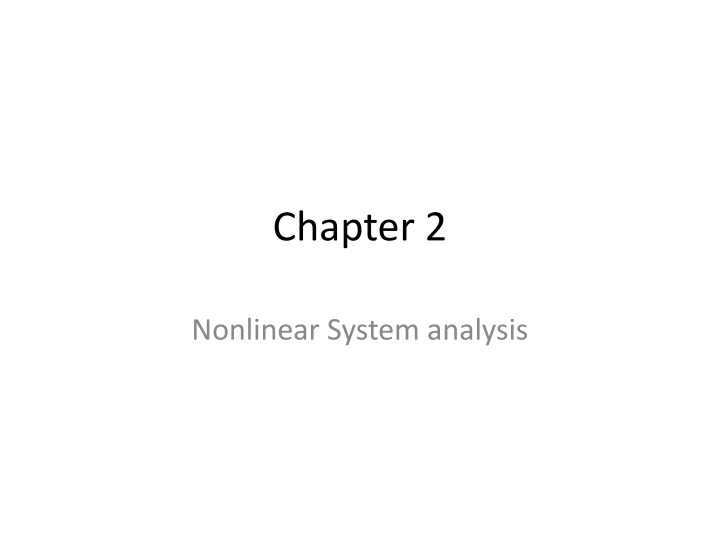
Nonlinear System Analysis: Phase Plane Methods & Existence Conditions
Explore the analysis of nonlinear systems using phase plane methods, Describing Function Method, and the conditions for the existence of solutions. Learn about Phase Plane Analysis, Global Lipschitz Condition, and more in the context of second-order systems.
Download Presentation

Please find below an Image/Link to download the presentation.
The content on the website is provided AS IS for your information and personal use only. It may not be sold, licensed, or shared on other websites without obtaining consent from the author. If you encounter any issues during the download, it is possible that the publisher has removed the file from their server.
You are allowed to download the files provided on this website for personal or commercial use, subject to the condition that they are used lawfully. All files are the property of their respective owners.
The content on the website is provided AS IS for your information and personal use only. It may not be sold, licensed, or shared on other websites without obtaining consent from the author.
E N D
Presentation Transcript
Chapter 2 Nonlinear System analysis
Contents Second Order Systems Phase plane analysis Describing function method
Second order systems Consider a nonlinear system described by A usual analysis method for such system is a plot of x1 vs x2 which is called state plane plot or state plane trajectory A special case of such systems is when
Analysis of nonlinear systems Existence of solution In linear systems, a solution to the system differential equation always exists and is unique However in nonlinear systems, solution may not exist or may not be unique To guarantee the existence and uniqueness of solution, conditions must be satisfied For a nonlinear system differential given by Two conditions for global existence are: Where kT and hT are constants
Analysis of nonlinear systems The above condition is called global Lipschitz condition Example: check if the following nonlinear system satisfies global Lipschitz condition A) B) Two important analysis methods are Phase plane analysis Describing function method
Phase plane analysis Is study of a second order system using graphical method Is a plot of motion trajectories corresponding to various initial conditions without solving the nonlinear system equations Used to analyze stability and motion patterns of the system
Phase plane analysis This is used for second order systems of the form For such systems, we choose two state variables x1 and x2 as Then the state equation becomes A plot of time variation of x2 versus x1 is known as phase plane plot or phase plane trajectory The phase plane trajectory gives some picture on the stability of the nonlinear system under study
Phase plane analysis Example: Consider the spring mass damper system shown below
Equilibrium points Consider a nonlinear state space model given by A vector xo is called an equilibrium if This means when a system has an equilibrium point, the system moves to the equilibrium point from any initial condition The system remains at the equilibrium point if it starts from it Equilibrium points are solutions of the differential equation Each solution point determines an equilibrium point
Equilibrium points Consider the system given by Determine the equilibrium points
Equilibrium points Equilibrium points are also known as singular points The slope of the phase portrait at the equilibrium points is indeterminate Stability is completely determined by the nature of the singular points for linear system but for nonlinear system limit cycle should also be considered
Phase plane analysis Phase portrait may have symmetry about the origin or about x1 or x2 axes Methods used Method of analytical solutions Method of isocline Delta method Pell s method
Phase portrait analysis Analytical method is solving the differential equation for x1 and x2 and then eliminating the time variable Directly solving the ration of dx2/dx1 and generating the equation relating x2 to x1 Consider the example below
Phase plane analysis The system dynamics and the control signal is given by Solving the dynamic equation analytically
Phase plane analysis Method of isocline Isocline is the locus of points with the same slope Consider the following system Then the isocline equation is
Phase plane analysis Determine the phase plane trajectory for Van der Pol s equation using isocline method and computer program. Compare your results
Describing function method This is a method which consists of replacing a nonlinear element with in a system by an equivalent linear time invariant system which gives the best approximation of the nonlinear system In replacing the nonlinear element with linear one we use various approximations Optimal quasi linearization Where a nonlinear system N is approximated by a linear system H and the approximation is measured by an error criteria given as Where the integral is integral of difference of impulse responses and r is a reference input
Describing function method The reference input usually taken is sinusoidal input For such an input the nonlinear system output will have transient part and steady state part Transient part is decaying Steady state part is periodic In optimal quasi linearization, we try to find a linear system which can have a similar steady state part to the first harmonic of the steady state part of the nonlinear system output for the input r(t) If we assume the first harmonic of the steady state output of the nonlinear system to be given by Then the optimal quasi linearization of the nonlinear system is given by a linear system whose frequency response is given by
Describing function method Describing function By definition the nonlinear system N is given by describing function of a Where Is the first harmonic of the steady state output of the nonlinear system and a is the amplitude of the sinusoidal input r
Describing function method Consider the sign nonlinear function given as The describing function of this nonlinearity is then Output of the nonlinear system for sinusoidal input is square wave whose first harmonic is 4/pi



















